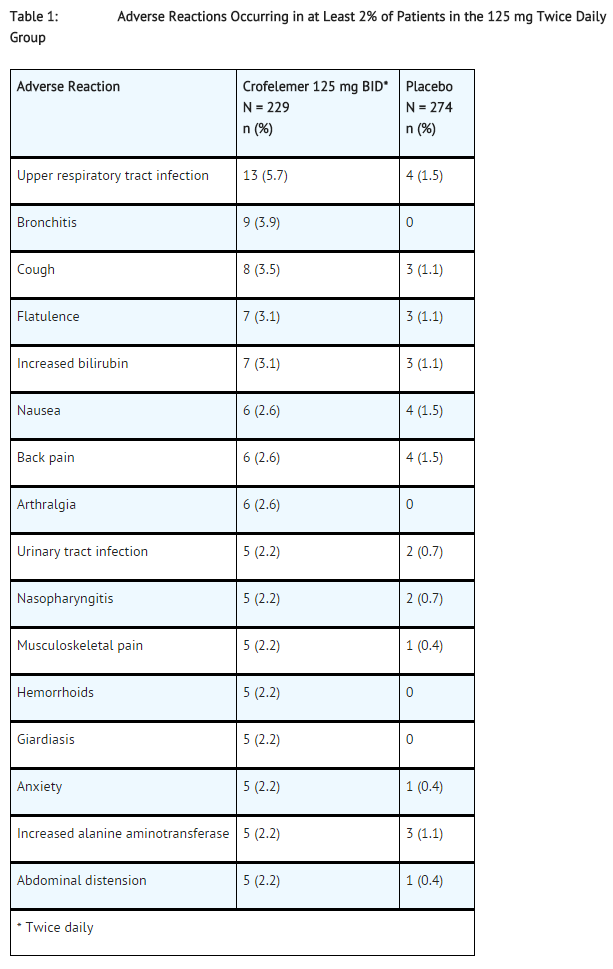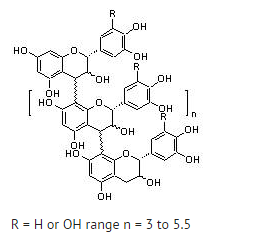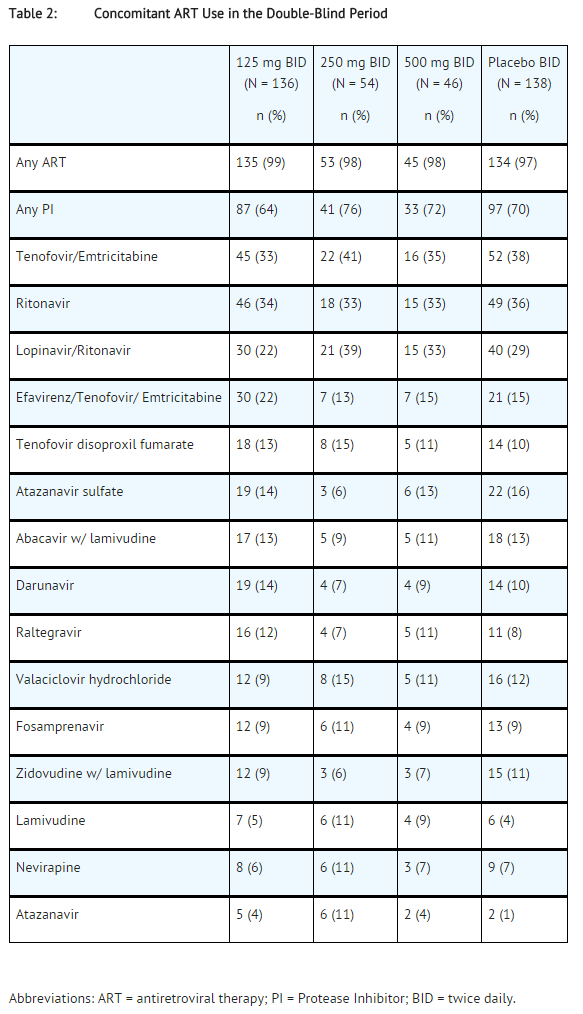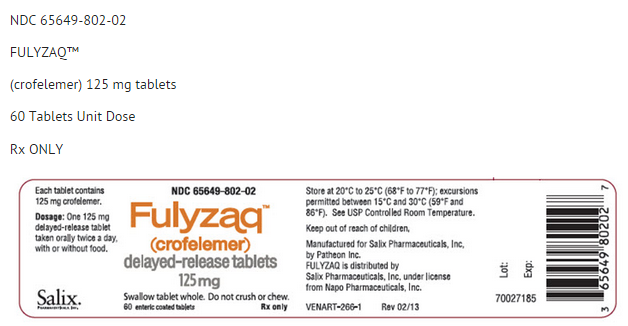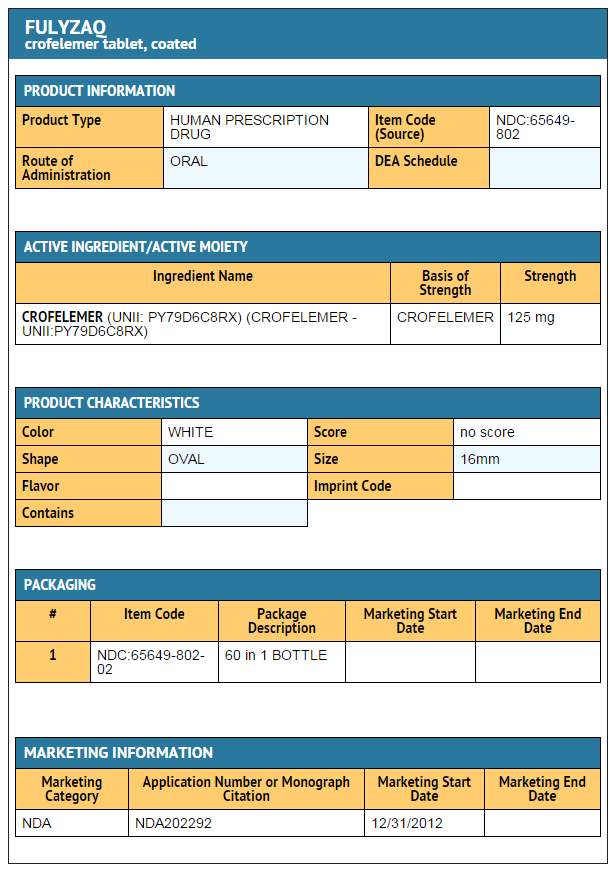Crofelemer
Editor-In-Chief: C. Michael Gibson, M.S., M.D. [1]; Associate Editor(s)-in-Chief: Rabin Bista, M.B.B.S. [2]
Disclaimer
WikiDoc MAKES NO GUARANTEE OF VALIDITY. WikiDoc is not a professional health care provider, nor is it a suitable replacement for a licensed healthcare provider. WikiDoc is intended to be an educational tool, not a tool for any form of healthcare delivery. The educational content on WikiDoc drug pages is based upon the FDA package insert, National Library of Medicine content and practice guidelines / consensus statements. WikiDoc does not promote the administration of any medication or device that is not consistent with its labeling. Please read our full disclaimer here.
Overview
Crofelemer is a anti-diarrheal that is FDA approved for the treatment of non-infectious diarrhea in adult patients with HIV/AIDS. Common adverse reactions include Upper respiratory tract infection, bronchitis, cough, flatulence and increased bilirubin.
Adult Indications and Dosage
FDA-Labeled Indications and Dosage (Adult)
Indications
- FULYZAQ is indicated for symptomatic relief of non-infectious diarrhea in patients with HIV/AIDS on Antiretroviral therapy.
Dosage
- The recommended dose of FULYZAQ is one 125 mg delayed-release tablet taken orally two times a day, with or without food. FULYZAQ tablets should not be crushed or chewed. Tablets should be swallowed whole.
DOSAGE FORMS AND STRENGTHS
- FULYZAQ is a white, oval, enteric-coated 125 mg delayed-release tablet printed on one side with 125SLXP.
Off-Label Use and Dosage (Adult)
Guideline-Supported Use
There is limited information regarding Off-Label Guideline-Supported Use of Crofelemer in adult patients.
Non–Guideline-Supported Use
There is limited information regarding Off-Label Non–Guideline-Supported Use of Crofelemer in adult patients.
Pediatric Indications and Dosage
FDA-Labeled Indications and Dosage (Pediatric)
The safety and effectiveness of FULYZAQ have not been established in pediatric patients less than 18 years of age.
Off-Label Use and Dosage (Pediatric)
Guideline-Supported Use
There is limited information regarding Off-Label Guideline-Supported Use of Crofelemer in pediatric patients.
Non–Guideline-Supported Use
There is limited information regarding Off-Label Non–Guideline-Supported Use of Crofelemer in pediatric patients.
Contraindications
- None
Warnings
Risks of Treatment in Patients with Infectious Diarrhea
- If infectious etiologies are not considered, and FULYZAQ is initiated based on a presumptive diagnosis of non-infectious diarrhea, then there is a risk that patients with infectious etiologies will not receive the appropriate treatments, and their disease may worsen. Before starting FULYZAQ, rule out infectious etiologies of diarrhea. FULYZAQ is not indicated for the treatment of infectious diarrhea.
Adverse Reactions
Clinical Trials Experience
Clinical Trials Experience
- Because clinical trials are conducted under widely varying conditions, adverse reaction rates observed in the clinical trials of a drug cannot be directly compared to rates in the clinical trials of another drug and may not reflect the rates observed in practice.
- A total of 696 HIV-positive patients in three placebo-controlled trials received FULYZAQ for a mean duration of 78 days. Of the total population across the three trials, 229 patients received a dose of 125 mg twice a day for a mean duration of 141 days, 69 patients received a dose of 250 mg twice a day for a mean duration of 139 days, 102 patients received a dose of 250 mg four times a day for a mean duration of 14 days, 54 patients received a dose of 500 mg twice a day for a mean duration of 146 days, and 242 patients received a dose of 500 mg four times a day for a mean duration of 14 days.
- Adverse reactions for FULYZAQ that occurred in at least 2% of patients and at a higher incidence than placebo are provided in Table 1.
- Adverse reactions that occurred in between 1% and 2% of patients taking a 250 mg daily dose of FULYZAQ were abdominal pain, acne, increased aspartate aminotransferase, increased conjugated bilirubin, increased unconjugated blood bilirubin, constipation, depression, dermatitis, dizziness, dry mouth, dyspepsia, gastroenteritis, herpes zoster, nephrolithiasis, pain in extremity, pollakiuria, procedural pain, seasonal allergy, sinusitis and decreased white blood cell count.
- Adverse reactions were similar in patients who received doses greater than 250 mg daily.
Postmarketing Experience
There is limited information regarding Postmarketing Experience of Crofelemer in the drug label.
Drug Interactions
Drug Interaction Potential
- In vitro studies have shown that crofelemer has the potential to inhibit cytochrome P450 isoenzyme 3A and transporters MRP2 and OATP1A2 at concentrations expected in the gut. Due to the minimal absorption of crofelemer, it is unlikely to inhibit cytochrome P450 isoenzymes 1A2, 2A6, 2B6, 2C9, 2C19, 2D6, 2E1 and CYP3A4 systemically .
- FULYZAQ administration did not have a clinically relevant interaction with nelfinavir, zidovudine, or lamivudine in a drug-drug interaction trial.
Use in Specific Populations
Pregnancy
- Reproduction studies performed with crofelemer in rats at oral doses up to 177 times the recommended daily human dose of 4.2 mg/kg revealed no evidence of impaired fertility or harm to the fetus. In pregnant rabbits, crofelemer at an oral dose of about 96 times the recommended daily human dose of 4.2 mg/kg, caused abortions and resorptions of fetuses. However, it is not clear whether these effects are related to the maternal toxicity observed. A pre- and postnatal development study performed with crofelemer in rats at oral doses of up to 177 times the recommended daily human dose of 4.2 mg/kg revealed no evidence of adverse pre- and postnatal effects in offspring. There are, however, no adequate, well-controlled studies in pregnant women. Because animal reproduction studies are not always predictive of human response, this drug should be used during pregnancy only if clearly needed.
- Australian Drug Evaluation Committee (ADEC) Pregnancy Category
There is no Australian Drug Evaluation Committee (ADEC) guidance on usage of Crofelemer in women who are pregnant.
Labor and Delivery
There is no FDA guidance on use of Crofelemer during labor and delivery.
Nursing Mothers
- It is not known whether crofelemer is excreted in human milk. Because many drugs are excreted in human milk and because of the potential for adverse reactions in nursing infants from FULYZAQ, a decision should be made whether to discontinue nursing or to discontinue the drug, taking into account the importance of the drug to the mother.
Pediatric Use
- The safety and effectiveness of FULYZAQ have not been established in pediatric patients less than 18 years of age.
Geriatic Use
- Clinical studies with crofelemer did not include sufficient numbers of patients aged 65 and over to determine whether they respond differently than younger patients.
Gender
There is no FDA guidance on the use of Crofelemer with respect to specific gender populations.
Race
There is no FDA guidance on the use of Crofelemer with respect to specific racial populations.
Renal Impairment
There is no FDA guidance on the use of Crofelemer in patients with renal impairment.
Hepatic Impairment
There is no FDA guidance on the use of Crofelemer in patients with hepatic impairment.
Females of Reproductive Potential and Males
There is no FDA guidance on the use of Crofelemer in women of reproductive potentials and males.
Immunocompromised Patients
There is no FDA guidance one the use of Crofelemer in patients who are immunocompromised.
CD4 Count and HIV Viral Load
- No dose modifications are recommended with respect to CD4 cell count and HIV viral load, based on the findings in subgroups of patients defined by CD4 cell count and HIV viral load.
- The safety profile of crofelemer was similar in patients with baseline CD4 cell count less than 404 cells/μL (lower limit of normal range) (N=388) and patients with baseline CD4 cell counts greater than or equal to 404 cells/μL (N=289).
- The safety profile of crofelemer was similar in patients with baseline HIV viral loads less than 400 copies/mL (N = 412) and patients with baseline HIV viral loads greater than or equal to 400 copies/mL (N = 278).
Administration and Monitoring
Administration
- Oral
Monitoring
There is limited information regarding Monitoring of Crofelemer in the drug label.
IV Compatibility
There is limited information regarding IV Compatibility of Crofelemer in the drug label.
Overdosage
- There has been no reported experience with overdosage of crofelemer.
Pharmacology
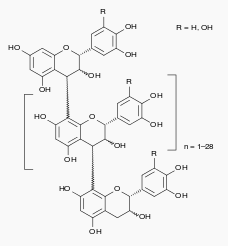
| |
Crofelemer
| |
| Systematic (IUPAC) name | |
| ? | |
| Identifiers | |
| CAS number | |
| ATC code | none |
| PubChem | ? |
| Chemical data | |
| Formula | (C15O6,7H12)n |
| Mol. mass | 860–9100 g/mol |
| Synonyms | SP-303 |
| Pharmacokinetic data | |
| Bioavailability | Little or no absorption from the gut |
| Metabolism | ? |
| Half life | ? |
| Excretion | ? |
| Therapeutic considerations | |
| Pregnancy cat. |
C(US) |
| Legal status |
[[Prescription drug|Template:Unicode-only]](US) |
| Routes | Oral (tablets) |
Mechanism of Action
- Crofelemer is an inhibitor of both the cyclic adenosine monophosphate (cAMP)-stimulated cystic fibrosis transmembrane conductance regulator (CFTR) chloride ion (Cl-) channel, and the calcium-activated Cl- channels (CaCC) at the luminal membrane of enterocytes. The CFTR Cl- channel and CaCC regulate Cl- and fluid secretion by intestinal epithelial cells. Crofelemer acts by blocking Cl- secretion and accompanying high volume water loss in diarrhea, normalizing the flow of Cl- and water in the GI tract.
Structure
- FULYZAQ (crofelemer) delayed-release tablets is an anti-diarrheal, enteric-coated drug product for oral administration. It contains 125 mg of crofelemer, a botanical drug substance that is derived from the red latex of Croton lechleri Müll. Arg. Crofelemer is an oligomeric proanthocyanidin mixture primarily composed of (+)‑catechin, (‑)‑epicatechin, (+)‑gallocatechin, and (‑)‑epigallocatechin monomer units linked in random sequence, as represented below. The average degree of polymerization for the oligomers ranges between 5 and 7.5, as determined by phloroglucinol degradation.
- Inactive ingredients: microcrystalline cellulose, croscarmellose sodium, colloidal silicon dioxide, and magnesium stearate.
- Coating ingredients: ethylacrylate and methylacrylate copolymer dispersion, talc, triethyl citrate, and white dispersion which contains xanthan gum, titanium dioxide, propyl paraben, and methyl paraben.
Pharmacodynamics
- Consistent with the mechanism of action of crofelemer (i.e., inhibition of CFTR and CaCC in the GI lumen), data suggest stool chloride concentrations decreased in patients treated with FULYZAQ (500 mg four times daily) (n=25) for four days relative to placebo (n=24); stool chloride concentrations decreased in both African American patients treated with FULYZAQ (n=3) relative to placebo (n=5) and non-African American patients treated with FULYZAQ (n=22) relative to placebo (n=19).
- At a dose 10 times the maximum recommended dose, crofelemer does not prolong the QTc interval to any clinically relevant extent.
Pharmacokinetics
Absorption
- The absorption of crofelemer is minimal following oral dosing in healthy adults and HIV‑positive patients and concentrations of crofelemer in plasma are below the level of quantitation (50 ng/mL). Therefore, standard pharmacokinetic parameters such as area under the curve, maximum concentration, and half-life cannot be estimated.
Distribution
- The distribution of crofelemer has not been determined.
Metabolism
- No metabolites of crofelemer have been identified in healthy subjects or patients in clinical trials.
Elimination
- The elimination route has not been identified in humans.
Food Effect
- Administration of crofelemer with a high-fat meal was not associated with an increase in systemic exposure of crofelemer in healthy volunteers. In the clinical trial, a single 500 mg dose of crofelemer was administered one-half hour before the morning and evening meals. Therefore, crofelemer may be administered with or without a meal.
Drug‑Drug Interactions
- Results of a crossover study in healthy volunteers showed crofelemer 500 mg administered four times daily for five days had no effect on the exposure of zidovudine and nelfinavir when administered as a single dose. A 20% decrease in lamivudine exposure was also observed in the same study but was not considered to be clinically important.
Nonclinical Toxicology
Carcinogenesis and Mutagenesis and Impairment of Fertility
Carcinogenesis
- Long-term studies in animals have not been performed to evaluate the carcinogenic potential of crofelemer.
Mutagenesis
- Crofelemer was negative in the bacterial reverse mutation assay, chromosomal aberration assay, and rat bone marrow micronucleus assay.
Impairment of Fertility
- Crofelemer, at oral doses of up to 738 mg/kg/day (177 times the recommended human daily dose of 4.2 mg/kg), had no effects on fertility or reproductive performance of male and female rats.
Clinical Studies
- The efficacy of FULYZAQ 125 mg delayed-release tablets twice daily was evaluated in a randomized, double-blind, placebo-controlled (one month) and placebo-free (five month), multi-center study. The study enrolled 374 HIV-positive patients on stable Antiretroviral therapy (ART) with a history of diarrhea for one month or more. Diarrhea was defined as either persistently loose stools despite regular use of anti-diarrheal medication (ADM) (e.g., loperamide, diphenoxylate, and bismuth subsalicylate) or one or more watery bowel movements per day without regular ADM use.
- Patients were excluded if they had a positive gastrointestinal (GI) biopsy, GI culture, or stool test for multiple bacteria (Salmonella, Shigella, Campylobacter, Yersinia, Mycobacterium), bacterial toxin (Clostridium difficile), ova and parasites (Giardia, Entamoeba, Isospora, Cyclospora, Cryptosporidium, Microsporidium), or viruses (Cytomegalovirus). Patients were also excluded if they had a history of ulcerative colitis, Crohn’s disease, celiac sprue (gluten-enteropathy), chronic pancreatitis, malabsorption, or any other GI disease associated with diarrhea.
- The study had a two-stage adaptive design. In both stages, patients received placebo for 10 days (screening period) followed by randomization to crofelemer or placebo for 31 days of treatment (double-blind period). Only patients with 1 or more watery bowel movements per day on at least 5 of the last 7 days in the screening period were randomized to the double-blind period. Each stage enrolled patients separately; the dose for the second stage was selected based on an interim analysis of data from the first stage. In the first stage, patients were randomized 1:1:1:1 to one of three crofelemer dose regimens (125, 250, or 500 mg twice daily) or placebo. In the second stage, patients were randomized 1:1 to crofelemer 125 mg twice daily or placebo. The efficacy analysis was based on results from the double-blind portion of both stages.
- Each study stage also had a five month period (placebo-free period) that followed the double-blind period. Patients treated with crofelemer continued the same dose in the placebo-free period. In the first stage, patients that received placebo were re-randomized 1:1:1 to one of the three crofelemer dose regimens (125, 250, or 500 mg twice daily) in the placebo-free period. In the second stage, patients that received placebo were treated with crofelemer 125 mg twice daily in the placebo-free period.
- The median time since diagnosis of HIV was 12 years. The percentage of patients with a CD4 cell count of less than 404 was 39%. The percentage of patients with a HIV viral load greater than or equal to 1000, 400 to 999, and less than 400 HIV copies/mL was 7%, 3%, and 9%, respectively; the remainder had a viral load that was not detectable. The median time since diarrhea started was 4 years. The median number of daily watery bowel movements was 2.5 per day.
- Most patients were male (85%). The percentage of patients that were Caucasian was 46%; the percentage of patients that were African-American was 32%. The median age was 45 years with a range of 21 to 68 years.
- In the double-blind period of the study, 136 patients received crofelemer 125 mg twice daily, 54 patients received 250 mg twice daily, 47 patients received 500 mg twice daily, and 138 patients received placebo. The percentages of patients that completed the double-blind period were 92%, 100%, 85%, and 94% in the 125 mg, 250 mg, 500 mg, and placebo arms, respectively.
- Most patients received concomitant protease inhibitors (PI) during the double-blind period (Table 2). The most frequently used ARTs in each group were tenofovir/emtricitabine, ritonavir, and lopinavir/ritonavir.
- The primary efficacy endpoint was the proportion of patients with a clinical response, defined as less than or equal to 2 watery bowel movements per week during at least 2 of the 4 weeks of the placebo-controlled phase. Patients who received concomitant ADMs or opiates were counted as clinical non-responders.
- A significantly larger proportion of patients in the crofelemer 125 mg twice daily group experienced clinical response compared with patients in the placebo group (17.6% vs. 8.0%, 1‑sided p < 0.01).
- In the randomized clinical study, examination of duration of diarrhea, baseline number of daily watery bowel movements, use of protease inhibitors, CD4 cell count and age subgroups did not identify differences in the consistency of the crofelemer treatment effect among these subgroups. There were too few female subjects and subjects with an HIV viral load > 400 copies/mL to adequately assess differences in effects in these populations. Among race subgroups, there were no differences in the consistency of the crofelemer treatment effect except for the subgroup of African-Americans; crofelemer was less effective in African-Americans than non-African-Americans.
- Although the CD4 cell count and HIV viral load did not appear to change over the one month placebo-controlled period, the clinical significance of this finding is unknown because of the short duration of the placebo-controlled period.
- Of the 24 clinical responders to crofelemer (125 mg twice daily), 22 entered the placebo-free period; 16 were responding at the end of month 3, and 14 were responding at the end of month 5.
How Supplied
- Crofelemer delayed-release tablets, 125 mg, are white, oval enteric-coated tablets printed on one side with 125SLXP. They are available in the following package size:
- Bottles of 60: NDC 65649-802-02
Storage
- Store at 20°C-25°C (68°F-77°F); excursions permitted between 15°C-30°C (59°F-86°F). See USP Controlled Room Temperature.
Images
Drug Images
{{#ask: Page Name::Crofelemer |?Pill Name |?Drug Name |?Pill Ingred |?Pill Imprint |?Pill Dosage |?Pill Color |?Pill Shape |?Pill Size (mm) |?Pill Scoring |?NDC |?Drug Author |format=template |template=DrugPageImages |mainlabel=- |sort=Pill Name }}
Package and Label Display Panel
PACKAGE LABEL - PRINCIPAL DISPLAY - FULYZAQ 125 MG TABLETS, 60 TABLETS BOTTLE LABEL
Ingredients and Appearance
{{#ask: Label Page::Crofelemer |?Label Name |format=template |template=DrugLabelImages |mainlabel=- |sort=Label Page }}
Patient Counseling Information
- Instruct patients that FULYZAQ tablets may be taken with or without food.
- Instruct patients that FULYZAQtablets should not be crushed or chewed. Tablets should be swallowed whole.
Precautions with Alcohol
- Alcohol-Crofelemer interaction has not been established. Talk to your doctor about the effects of taking alcohol with this medication.
Brand Names
- Fulyzaq®[1]
Look-Alike Drug Names
There is limited information regarding the look alike drug names.
Drug Shortage Status
Price
References
The contents of this FDA label are provided by the National Library of Medicine.
Template:Antidiarrheals, intestinal anti-inflammatory/anti-infective agents
